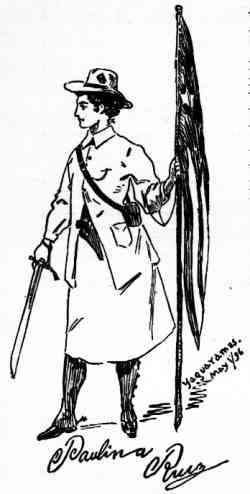
Madame Paulina Ruiz Gonzalez
An excerpt from:
Marching with Gomez
By Grover Flint, 1898
Page 85:
There was at this time, as guest of the woman who owned the roosters, Madame Paulina Ruiz Gonzalez, wife of Captain Rafael Gonzales, an officer of Pancho Perez, brigadier-general of the Santa Clara division. Some months before she had left her home in Corral Falso by night, and met a party of insurgents on the outskirts of the town.

She rode off, astride an extra horse, to the force of Manolo Menendez, where her husband was at the time. She was too plucky and too proud to be one of the impedimenta, so she begged Pancho Perez to let her carry the flag. Two days after she carried the standard very gallantly under a hot shower of Mauser bullets, and was appointed lieutenant for bravery. On the fifth of February, at Mango Largo, she led in two machete charges against the guerrilla of Corral Falso. With the standard slung from her left arm, she rode with a machete in the front rank, beside Pancho Perez himself. Here she gave the machete to two guerilleros. One she struck three times, shouting "Viva Cuba libre," and cut him down from his saddle. Both lay dead on the field when the guerilla retired. She had two horses shot under her. One in the engagement of Villa de Habaco, on the last day of March, and the other when Manolo Menendez' troop rode into an ambuscade near Bolondron. She had already taken part in ten battles and skirmishes, always under gun-fire, and where the machetes fell oftenest, but she had never been wounded.
Madame Gonzales wore a linen coat and a short skirt that showed a pair of striped trousers beneath. She was twenty-one years old and very pretty, with regular features, soft dark eyes, glossy black hair that curled over her forehead, and a gentle, persuasive voice. She was slim as a poplar and very graceful.
They told me she held an honorary commission from Pancho Perez as capitana banderada or flag captain. General Perez was then lying wounded in a field hospital in the peninsula Zapata, and she was awaiting his return, to once more carry the standard of the Santa Clara division.
When I met Madame Gonzales, she had lost her hat, and I made her accept my own, an American cow-puncher's sombrero, and showed her how to give it the proper "Denver poke." This readiness on my part to incur sunstroke paved the way to an interview.
"Were you ever afraid?" I asked.
"Gracious! No, Señor," she answered, with a little laugh. The thought that one could experience fear seemed to amuse her mightily.
"Did you not feel a little strange when you heard the first volley and saw men falling about you?"
"No, no, Señor, I never felt afraid in my life, but in my first action I was impatient. My horse could not go to the enemy quick enough. I rode my first charge without giving the machete to any one. We were all hurried together and crowded from this side and from that. I saw the machetes flash near me, and heard the rattle and clash, but I found no one in front of me. Then it was all dust and the enemy had gone. Our men were all crowding about the flag, and cheering, but figure to yourself, Señor, I had met nobody and I felt I had come out for nothing, though they told me the centre where I rode cut the line of soldiers right in two. As for me, I heard shots and the dust choked me, and I was crowded to this side and that but I could strike no one, and I had to put my machete back, feeling that I had not struck for Cuba."
"Would you like to kill a Spaniard?" I asked.
"But no, Señor, I would not for the world kill any one, but figure to yourself, when you ride against an enemy, that is a different thing. You strike for Cuba and you think only of Cuba. I have struck with the machete, but it was not as if I had hurt any one. They fell, but you know it was for Cuba and I would not hurt any one."
-
[You'll probably have to go to the library for this one,
but it will be worth the effort.
972.9 F646m]
Related:
War of Independence | Excerpt from: "Liberty - The Story of Cuba," by Horatio S. Rubens. Chapter 1
tells the author's experience during a Key West tobacco workers strike in 1893,
just before the start of the War of Independence | Learn about José
Martí | Learn about Antonio
Maceo